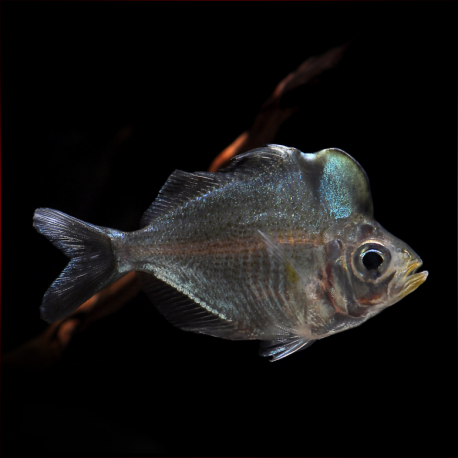More info
Datasheet
| Minimum Tank Size | 80 litres / 21.13 US gallons |
| Maximum Size | 10.0cm / 3.94inches |
| Temperature | 23°C / 73.40°F - 27°C / 80.60°F |
| Hardness | 8-15ºdH |
| pH | 7.0-7.5 |
General Description
The Humphead Perchlet (Parambassis Pulcinella) is a species that was newly discovered in 2003 and is still relatively unknown in terms of its natural behavior. Characterized by a distinctive hump on its head, which is a spine extension and scaleless, this freshwater fish has been subject to unethical practices such as artificial dyeing, significantly impacting its lifespan. Endemic to Myanmar, it reaches a maximum size of 10.0cm, requiring a minimum tank size of 80 litres.
Aquarium Setup
Maintaining the Humphead Perchlet in captivity does not demand specific decor, allowing for personal preferences with the addition of plants, rocks, and driftwood. Being a freshwater species, there is no necessity for adding salt to its tank. Water conditions should ideally be maintained at a temperature of 23-27°C, a pH range of 7.0-7.5, and a hardness level of 8-15°dH (see table).
Behaviour
Considered a peaceful species overall, the Humphead Perchlet may exhibit intimidating behavior towards smaller fish due to its active nature and adult size. Suitable tankmates include rainbowfish, barbs, and loaches. While they can be kept in groups, occasional minor squabbles may occur among them, typically limited to mild chasing.
Feeding and Diet
The Humphead Perchlet readily accepts dried pellets or flakes but should have its diet supplemented with regular feedings of live and frozen foods like bloodworms and brine shrimp to ensure a nutritious intake.
Reproduction & Dimorphism
Reproduction of the Humphead Perchlet has not yet been accomplished in aquarium settings. Sexual dimorphism is observable, with male individuals displaying a larger hump on their heads compared to females.
Habitat and Distribution
Inhabiting large freshwater streams characterized by fast-flowing, well-oxygenated, and clear water, the Humphead Perchlet thrives in biotopes with smooth, water-worn rocks and boulders of various sizes. It is exclusively endemic to Myanmar.

